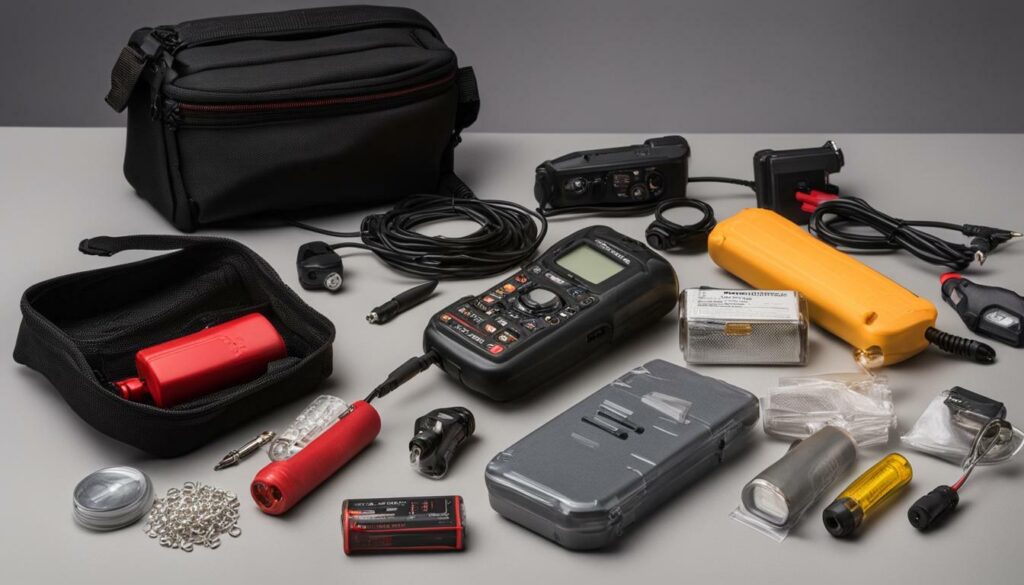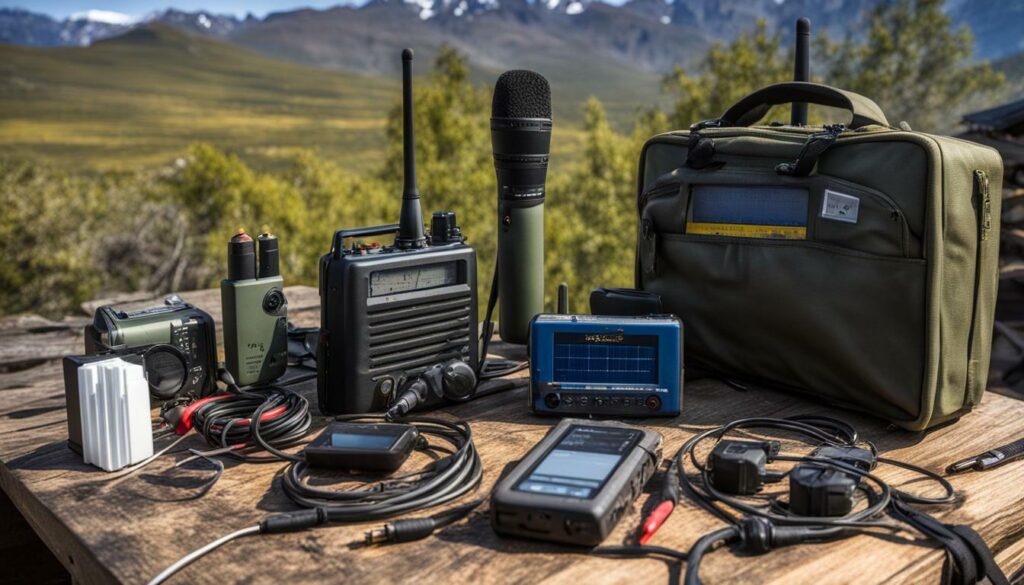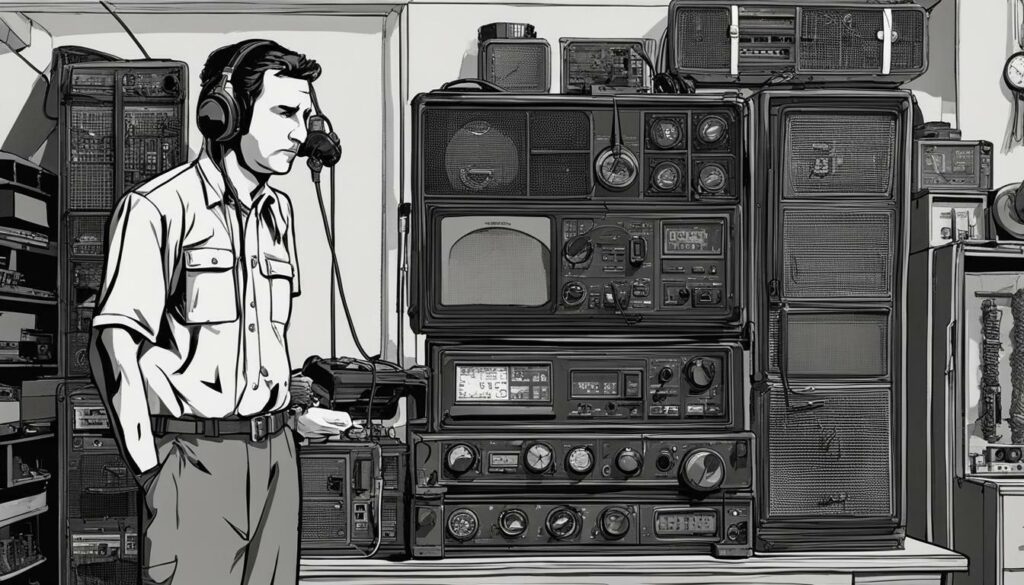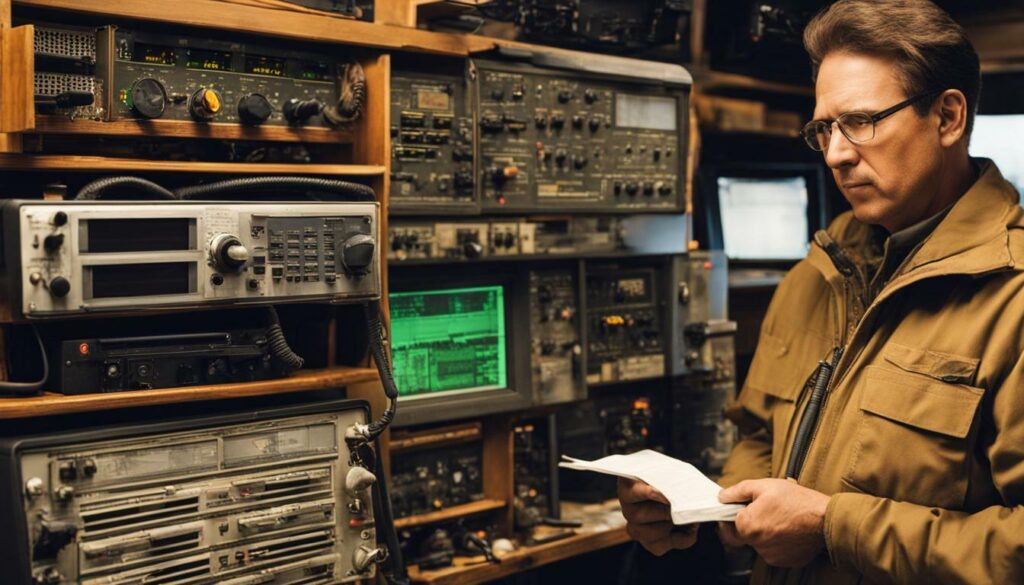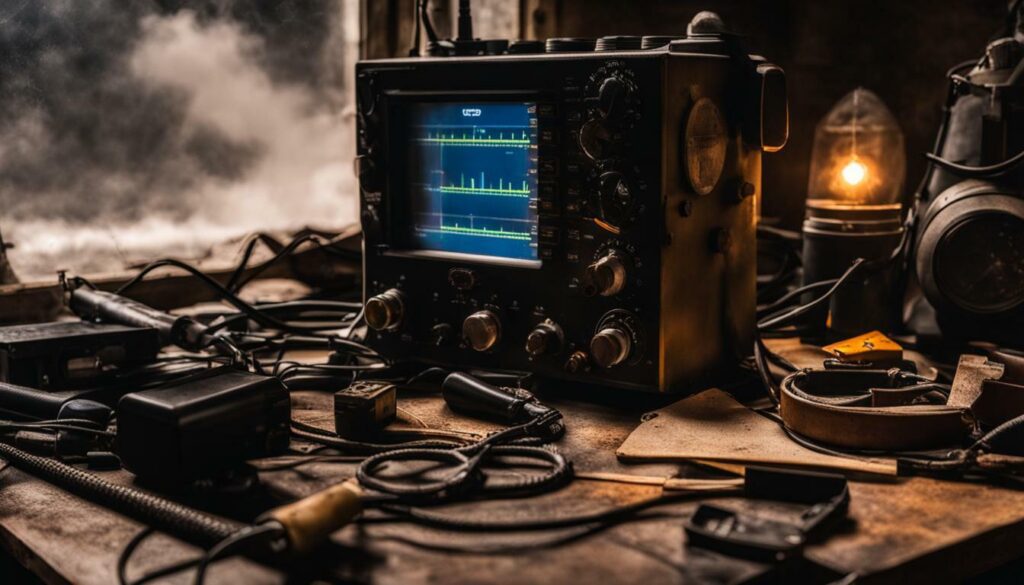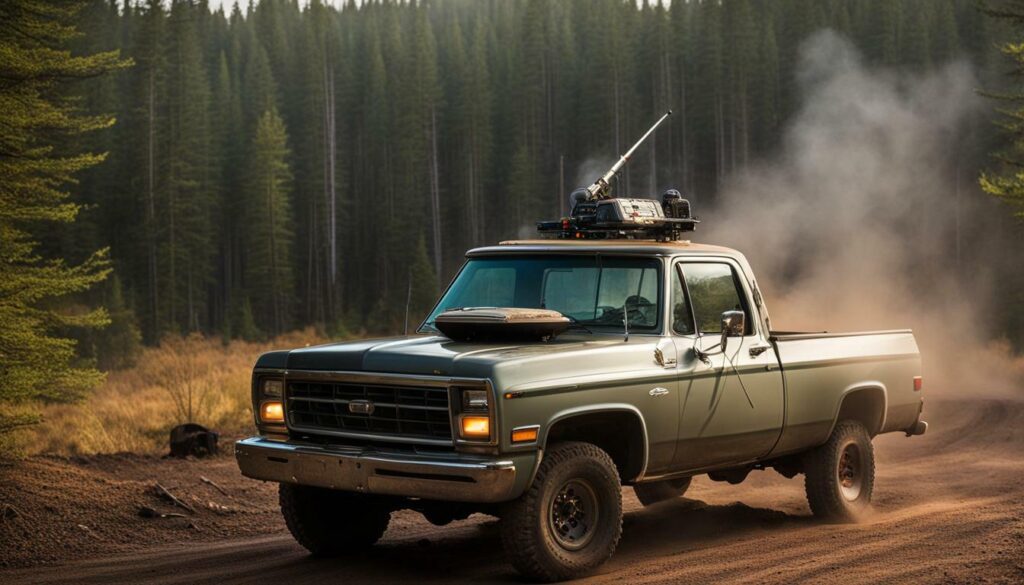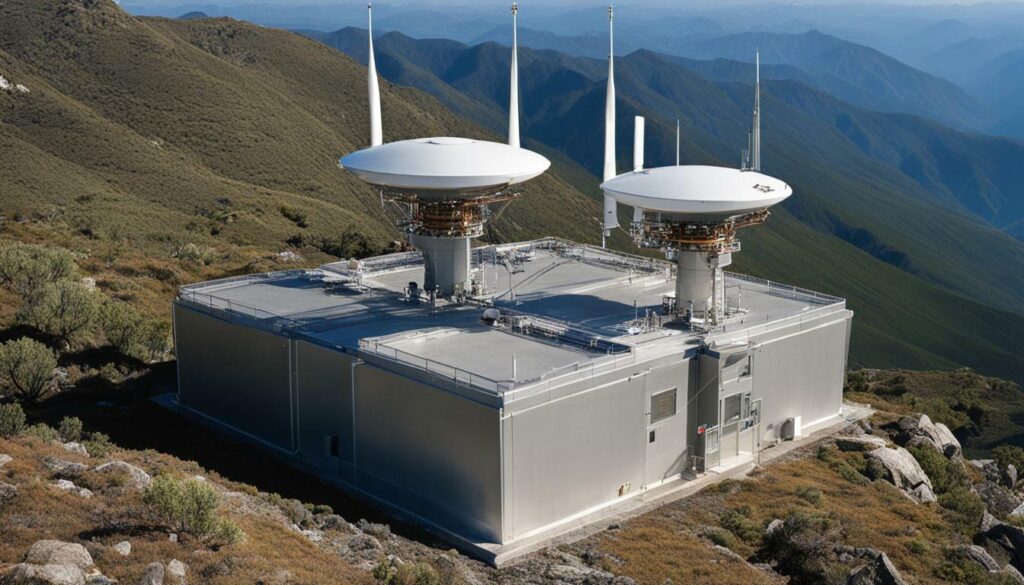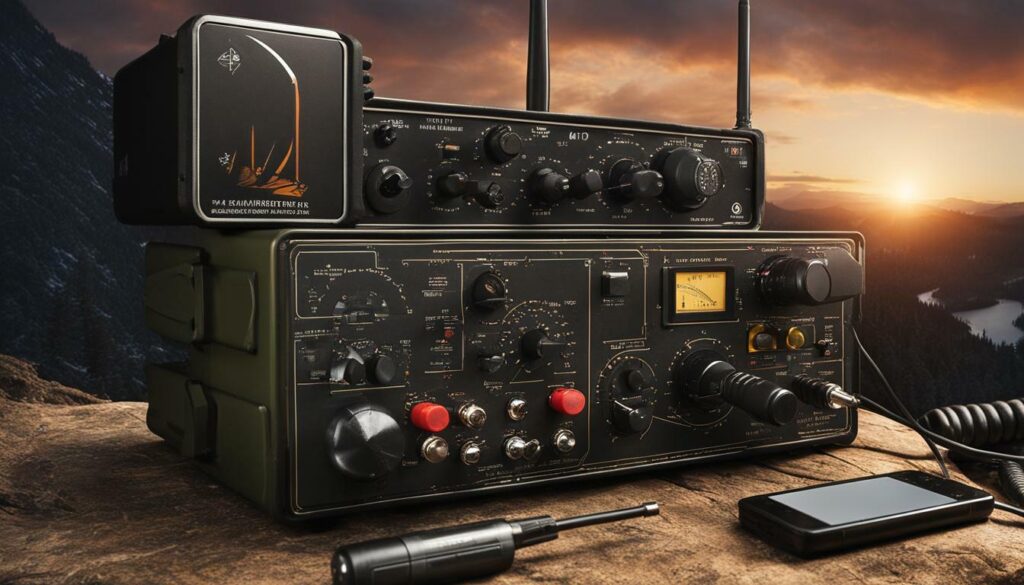
Welcome to my essential guide on prepper ham radio, a vital tool for survival enthusiasts during emergencies. When traditional communication channels fail in critical situations, having a reliable means of staying connected is crucial. That’s where prepper ham radio comes in.
Key Takeaways:
- Prepper ham radio is essential for survival enthusiasts during emergencies.
- When communication channels are down, ham radio provides a reliable means of staying connected.
- Ham radio is versatile and can be used in various scenarios.
- Obtaining a ham radio license is necessary to operate legally and effectively.
- Choosing the right ham radio equipment is important for coverage and power sources.
Why Ham Radio is Necessary in Emergency Situations
When disaster strikes and traditional communication channels are compromised, preppers turn to ham radio as a reliable emergency communication method. In a post-apocalyptic scenario or during natural disasters, ham radio operators can establish vital connections and share information with fellow preppers, emergency services, and other relevant organizations.
Unlike cell phones and internet-based communication platforms, ham radios can work independently of external infrastructure. They operate using radio waves and do not rely on cellular towers or internet connectivity, making them highly dependable when other forms of communication fail.
In addition to being self-reliant, ham radios provide a level of versatility that sets them apart from alternative communication methods. Whether it’s short-range local communications or long-range broadcasts, ham radios can cover various distances depending on factors such as frequency, power output, and antenna configuration.
Furthermore, ham radio operators can establish networks of communication through repeaters and linked systems. These networks enable the exchange of information over long distances, even across multiple states, ensuring that preppers can stay connected and informed during critical times.
Why Ham Radio is Necessary in Emergency Situations
“In the aftermath of a disaster, when traditional communication channels are down, ham radio operators become a lifeline of information and assistance. They bridge the gap and provide a means of communication that is immune to infrastructure failures. It’s not just a hobby; it’s a crucial survival tool.”
However, it’s important to note that ham radio operation requires a license from the Federal Communications Commission (FCC). This licensing system ensures that operators have the necessary knowledge to operate the radio equipment efficiently and responsibly.
Obtaining a ham radio license involves studying and passing a licensing exam. There are different license types available, each granting specific privileges and operating frequencies. Preppers must understand the licensing requirements in their area and choose the appropriate license for their needs.
In the next sections, we will explore the different types of ham radios suitable for preppers, including handheld radios, mobile radios, and base stations. We will provide guidance on choosing the right radio and discuss the importance of ham radio in SHTF scenarios. Additionally, we’ll provide resources for studying and preparing for the ham radio licensing exams, ensuring that preppers have the knowledge and skills to operate their radios effectively in emergency situations.
Unlike traditional communication systems, ham radio provides survivalists with a versatile means of communication in various emergency scenarios. Whether you’re preparing for a natural disaster or a societal breakdown, having reliable communication gear is essential for staying informed and connected with others. Ham radio, also known as amateur radio, offers several advantages that make it a vital tool for preppers.
- Long-range communication: Ham radios can transmit signals over long distances, allowing you to maintain contact with other preppers, emergency responders, and even distant relatives during times of crisis.
- Independent infrastructure: In situations where traditional communication channels like cell towers and internet services are down, ham radio operates independently. This self-reliance ensures that you can stay connected even when the grid fails.
- Flexibility of frequencies: Ham radio enthusiasts have access to a wide range of frequencies and modes, enabling communication through voice, text, and digital formats. This flexibility ensures adaptability to different situations and evolving technologies.
- Community support: The ham radio community is a strong and interconnected network of enthusiasts who are always willing to lend a helping hand. During emergencies, survivalists can rely on fellow ham radio operators for assistance, information, and collaboration.
“Having a ham radio in your prepping gear is like having a lifeline to the world when everything else fails. It’s not just a hobby; it’s a crucial tool for survival.”
While ham radio offers numerous benefits, it’s essential to consider some drawbacks as well. Obtaining a ham radio license is mandatory, as operating without one is illegal. The licensing process involves passing exams to demonstrate knowledge of regulations and operating practices. However, the knowledge gained through licensing ensures efficient and responsible use of radio frequencies.
When selecting a ham radio for survival situations, it’s important to consider factors such as coverage range, battery life, power sources, and additional features like weather alerts and emergency channels. Handheld radios are portable and convenient for short-range communication, while mobile radios provide increased power and coverage. For long-range communication, base stations equipped with powerful antennas can be set up at a fixed location.
Ham radio is a powerful tool for preppers
With its versatility, independent infrastructure, and community support, ham radio serves as a lifeline for survivalists in times of need. By incorporating ham radio into your emergency communication gear, you can enhance your preparedness and stay connected when traditional systems fail. So, explore the world of ham radio, obtain the necessary licensing, and equip yourself with the right gear to ensure effective communication during critical situations.
While ham radio offers significant benefits for preppers, it is important to consider its drawbacks as well. One of the major advantages of ham radio is its ability to provide reliable communication in disaster scenarios when traditional channels fail. In emergency situations, ham radio operators can establish communication networks and coordinate relief efforts, ensuring that crucial information is shared efficiently. Ham radio also allows preppers to stay connected with the outside world, providing a lifeline for communication during extended periods of isolation.
Another benefit of ham radio is its versatility. Unlike other communication methods, ham radio can operate independently of the internet and phone networks. It can be used to transmit voice, data, and even images, making it a valuable tool for relaying critical information during emergencies. Additionally, ham radio can cover vast distances when equipped with the right equipment, enabling communication over long ranges.
“Ham radio has been an essential part of my prepping gear for years. It has not only allowed me to communicate with fellow preppers during drills and exercises, but also provided a means of staying informed and connected during real emergencies. It’s a reliable and versatile tool that every prepper should consider.”
However, there are a few drawbacks to using ham radio as well. One of the main challenges is the need for a license to operate a ham radio. Obtaining a license requires studying and passing an examination, which can be time-consuming. Additionally, ham radios can be bulky and require power sources, such as batteries or generators, which may not always be readily available in emergency situations.
In conclusion, ham radio is a valuable communication tool for preppers, offering reliable and versatile communication capabilities. While it has certain drawbacks, such as the need for a license and reliance on power sources, the benefits outweigh the disadvantages. Preppers should consider obtaining the necessary license and selecting a suitable ham radio to enhance their emergency preparedness efforts.
Operating a ham radio requires a license, and understanding the different license types is crucial for preppers. The Federal Communications Commission (FCC) governs ham radio licensing in the United States, and they offer three main licenses: Technician, General, and Amateur Extra. Each license has its own privileges and examination requirements.
The Technician license is the entry-level license and grants access to most ham radio frequencies. It requires passing a written examination that covers basic electronics, radio regulations, and operating procedures. With a Technician license, preppers can communicate within their local area and participate in emergency communication networks.
The General license allows for additional operating privileges and access to more frequencies. The examination for this license includes more advanced radio theory and regulations. Having a General license expands the geographic range and communication possibilities for preppers, making it a valuable upgrade.
The highest level of licensing is the Amateur Extra license. This license offers the broadest operating privileges and is obtained by passing a comprehensive examination. With an Amateur Extra license, preppers have access to all amateur radio bands and can communicate worldwide. The knowledge and privileges gained from this license make it ideal for preppers who want to be fully prepared for any emergency scenario.
Summary:
Operating a ham radio requires a license, and preppers have three options to choose from: Technician, General, and Amateur Extra. The Technician license is the entry-level license, providing access to local communication networks. The General license expands the operating privileges and geographic range. The Amateur Extra license grants the highest level of communication privileges, allowing preppers to communicate worldwide. Obtaining the appropriate license is essential for preppers to maximize their ham radio capabilities and stay connected in emergency situations.
Choosing the Right Ham Radio for Survival
Selecting the appropriate ham radio for survival requires careful consideration of various factors to ensure effective communication during emergencies. Whether you’re a seasoned prepper or just starting to build your emergency preparedness kit, having a reliable ham radio is essential. Here are some key factors to keep in mind when choosing a ham radio for survival.
1. Coverage:
Consider the frequency range and transmission power of the ham radio. Look for radios that cover a wide range of frequencies and offer both VHF (Very High Frequency) and UHF (Ultra High Frequency) capabilities. This will increase your chances of reaching other operators in different areas or under varying terrain conditions.
2. Battery Life and Power Sources:
In emergency situations, power sources may be limited. Look for ham radios that have long battery life and can also be powered by alternative sources like solar panels or hand-crank generators. Some radios even have a built-in rechargeable battery pack for convenience.
3. Extra Features:
Consider any additional features that may be useful in emergency situations. Look for radios that have built-in NOAA weather alerts, flashlight or SOS signals, and even an AM/FM radio for staying updated on general news. These features can be invaluable during times of crisis.
Once you have evaluated these factors, it’s important to test and practice using your chosen ham radio. Familiarize yourself with its functions and capabilities, and ensure that you have a clear understanding of emergency communication protocols. Remember, communication is key during survival scenarios, and having the right ham radio can make all the difference.
| Factors to Consider | Ham Radio Model A | Ham Radio Model B | Ham Radio Model C |
|---|---|---|---|
| Coverage | Wide frequency range | VHF and UHF capabilities | Limited frequency range |
| Battery Life | Long lasting, rechargeable | Short battery life, replaceable | Medium battery life, solar powered |
| Extra Features | Built-in NOAA alerts, AM/FM radio | SOS signals, flashlight | No additional features |
Role of Ham Radio in SHTF Scenarios
In SHTF scenarios, ham radio becomes a lifeline for preppers, providing essential communication capabilities when all other systems fail. When disaster strikes and traditional communication channels are down, preppers rely on ham radio to keep in touch with loved ones, gather crucial information, and coordinate rescue efforts. Unlike other communication methods, ham radio operates independent of internet or cellular networks, making it a reliable option when all else fails.
Ham radio’s versatility is a key factor in its importance for preppers. With the right equipment and training, ham radio operators can communicate over long distances, even in remote or isolated areas. This makes it an invaluable tool for emergency response teams, aiding in search and rescue missions and providing updates on the situation.
To operate a ham radio legally, a license is required. The licensing process ensures that operators have the necessary knowledge and skills to operate their radios safely and efficiently. There are different license types available, ranging from basic Technician licenses to advanced Extra licenses. Preppers should obtain the appropriate license for their needs, taking into consideration their communication requirements and the areas they plan to operate in.
| License Type | Privileges |
|---|---|
| Technician | Basic voice and data communication on specific frequency bands |
| General | Expanded privileges including long-distance communication |
| Extra | Full privileges on all amateur radio bands |
It is essential for preppers to choose the right ham radio equipment for their survival needs. Factors such as coverage, battery life, power sources, and additional features should be considered. Portable handheld radios are popular among preppers for their portability and ease of use. Mobile radios, designed for use in vehicles, provide a higher power output and extended range. Base stations, with their larger antennas and higher power capabilities, offer long-range communication for preppers with fixed locations.
Studying Resources for Ham Radio Licensing
To obtain a ham radio license, preppers can access a variety of resources to study and prepare for the licensing exam. Whether you are a beginner or have some knowledge of ham radio operation, these resources can help you gain the necessary skills and knowledge to become a licensed operator.
One of the most popular resources for studying ham radio is online study guides and practice exams. Websites such as ARRL offer comprehensive study materials, including manuals, tutorials, and sample exams. These resources cover all the topics required for the licensing exam, from basic radio theory to regulatory rules and operating procedures.
Another valuable resource is joining a local ham radio club. These clubs often offer classes and workshops specifically designed to help aspiring operators prepare for the exam. Additionally, being part of a club provides access to experienced operators who can provide guidance and support throughout your licensing journey.
Lastly, don’t underestimate the power of hands-on experience. Connecting with fellow preppers and participating in local ham radio events, such as field days or emergency preparedness drills, can give you practical experience and enhance your understanding of ham radio operation.
| Studying Resources: | Pros: | Cons: |
|---|---|---|
| Online study guides and practice exams | Accessible from anywhere, comprehensive study materials | May not provide hands-on experience |
| Local ham radio clubs | Classes and workshops, guidance from experienced operators | Limited to local availability, may require membership fees |
| Hands-on experience | Practical knowledge, real-world application | Dependent on local events and opportunities |
Remember, obtaining a ham radio license not only ensures that you are legally compliant but also enhances your ability to communicate effectively in emergency situations. It’s crucial to invest time and effort into studying and preparing for the licensing exam to become a proficient ham radio operator.
Handheld Ham Radios for Preppers
Handheld ham radios are popular among preppers due to their portability and versatility, making them an essential part of prepping radio gear. Whether you’re bugging out or hunkering down during an emergency, having a reliable means of communication is crucial. With their compact size, handheld ham radios can easily be carried in a bug-out bag or kept within reach at your safe space.
One of the key advantages of handheld ham radios is their ability to operate on both VHF (Very High Frequency) and UHF (Ultra High Frequency) bands, allowing for a wider range of communication options. This versatility ensures that you can connect with other ham radio operators nearby, as well as reach repeaters or satellites for longer-range communication.
Furthermore, many handheld ham radios come equipped with additional features that enhance their usefulness in emergency situations. Some models offer built-in weather alerts, allowing you to stay informed about approaching storms or other hazardous conditions. Others have built-in flashlights or even solar panels for charging on the go, ensuring that you can stay connected even in off-grid scenarios.
| Model | Frequency Range | Power Output | Battery Life | Extra Features |
|---|---|---|---|---|
| Baofeng UV-5R | 136-174 MHz (VHF) 400-520 MHz (UHF) |
4-5 watts | 8-12 hours | Dual-band, FM radio, flashlight |
| Yaesu FT-60R | 144-148 MHz (VHF) 430-450 MHz (UHF) |
5 watts | 10-12 hours | Dual-band, weather alerts, emergency channel |
| Kenwood TH-D74A | 144-148 MHz (VHF) 430-450 MHz (UHF) |
5 watts | 8-10 hours | Dual-band, APRS (Automatic Packet Reporting System), built-in GPS |
When selecting a handheld ham radio, consider factors like frequency range, power output, battery life, and any extra features that may be beneficial to your specific needs. Remember to also familiarize yourself with your local regulations regarding ham radio use and licensing requirements to ensure that you stay compliant while enjoying the benefits of this important communication tool.
Mobile Radios for Emergency Communications
When setting up a reliable emergency communication system, preppers often rely on mobile ham radios for their extended range and power. These versatile devices play a crucial role in keeping preppers connected during SHTF scenarios when traditional communication methods fail.
Mobile ham radios offer several advantages that make them an essential piece of prepper communication gear. Firstly, they provide a wider coverage range compared to handheld radios, allowing preppers to reach out to a larger network of operators and emergency services. This extended range is especially valuable in remote areas or during natural disasters where communication infrastructure may be compromised.
Additionally, mobile ham radios come with higher power capabilities, which translates to stronger signals and better communication quality. This increased power allows preppers to overcome obstacles such as interference or weak signals, ensuring clear and reliable communication even in challenging situations. Pairing a mobile radio with a suitable antenna can further enhance its reach and performance.
| Advantages of Mobile Ham Radios | Disadvantages of Mobile Ham Radios |
|---|---|
|
|
When selecting a mobile ham radio for emergency communications, preppers should consider factors such as frequency coverage, power output, ease of use, and additional features like emergency alert systems and weather channels. It’s important to choose a radio that aligns with your specific needs and the requirements of your emergency communication strategy.
The XYZ mobile ham radio is a top choice among preppers for its exceptional coverage range and powerful performance. With an output of 50 watts, it ensures clear and reliable communication in even the most challenging conditions. Its durable construction and user-friendly interface make it a trusted companion for emergency situations. The XYZ radio also features an integrated emergency alert system and weather channels, providing vital information in real-time. Whether you’re preparing for a natural disaster or planning remote excursions, the XYZ mobile ham radio is a reliable and versatile communication tool for preppers.”
By including a mobile ham radio in your emergency preparedness gear, you can enhance your communication capabilities and stay connected when it matters most. Remember to obtain the necessary ham radio license and familiarize yourself with the operating procedures to ensure effective and legal use of your radio equipment.
Base Stations for Long-Range Communication
Base stations serve as powerful communication hubs for preppers, enabling long-range communication capabilities during emergencies. These stationary radio setups provide a reliable and extensive reach, allowing preppers to connect with other individuals or groups over vast distances. By utilizing base stations, preppers can establish a central communication point that can transmit and receive signals over a wider area compared to handheld or mobile radios.
When setting up a base station, preppers can take advantage of various antenna options to enhance their communication range. High-gain antennas, such as Yagi or directional antennas, allow for focused and stronger radio signals in a specific direction. This can be particularly useful when attempting to communicate with counterparts located far away or in remote areas.
One key advantage of utilizing base stations is the ability to maintain a constant power source. Unlike handheld or mobile radios that rely on batteries or limited power supplies, base stations can be connected to main power sources or external battery systems, ensuring continuous communication capabilities even during extended emergencies or power outages. Additionally, base stations often come equipped with extra features, such as built-in frequency scanners, adjustable power settings, and the ability to connect external equipment or accessories.
Setting up a Base Station
When establishing a base station for long-range communication, preppers should consider several factors. Firstly, they should select a suitable location that offers a clear line of sight and minimal obstruction for optimal signal propagation. Additionally, preppers should invest in quality antenna systems, grounding to minimize interference, and efficient coaxial cables that minimize signal loss.
A comprehensive setup may include a base station radio, an antenna system, coaxial cables, a power supply, and a grounding system. It is crucial to ensure that all components are compatible with each other to ensure seamless operation and maximize the range of communication.
| Base Station Setup Checklist |
|---|
| ✔️ Base station radio |
| ✔️ High-gain antenna |
| ✔️ Coaxial cables |
| ✔️ Power supply |
| ✔️ Grounding system |
By implementing a properly designed base station, preppers can establish long-range communication capabilities, keeping them connected with other survival enthusiasts and emergency response networks during critical situations.
Prepper ham radio is an indispensable tool for survival enthusiasts, providing reliable communication during emergencies when traditional channels fail. In times of crisis, such as natural disasters or widespread power outages, ham radio operators can easily communicate with one another, creating a vital network for sharing information and coordinating rescue efforts.
Ham radio’s necessity becomes even more apparent when considering the limitations of other communication methods. Unlike cell phones or internet-based systems, ham radio does not rely on existing infrastructure and can operate independently. This versatility allows preppers to stay connected even in remote areas or when all other forms of communication are down.
However, it’s important to acknowledge that ham radio also has its drawbacks. One significant challenge is the need for a license to operate a ham radio. Obtaining a license requires passing an exam, which tests knowledge of radio regulations and operating procedures. Preppers should be aware of the different license types available and choose the appropriate one based on their needs and level of involvement.
When selecting a ham radio for survival purposes, several factors should be considered. Coverage range, battery life, power sources, and additional features, such as weather alerts or emergency channels, play a crucial role in determining which radio is the most suitable. It’s essential for preppers to carefully evaluate their requirements and choose a ham radio that meets their specific needs.
In SHTF scenarios, ham radio takes center stage as a reliable means of communication. When traditional channels fail due to infrastructure damage or overload, ham radio operators can continue to transmit messages, gather critical information, and provide assistance to those in need. The ability to communicate effectively during these situations can significantly increase survival chances and aid in the recovery process.
To prepare for ham radio licensing exams, there are various resources available to help aspiring operators study and familiarize themselves with the necessary concepts. These resources include online courses, study guides, practice exams, and local amateur radio clubs that offer training and mentorship. By investing time and effort into studying, preppers can obtain the required license and gain the skills needed to confidently operate a ham radio.
Lastly, preppers can choose from a range of ham radios suited to different situations. Handheld radios, also known as portable transceivers, offer mobility and are ideal for on-the-go communication. Mobile radios, designed for vehicle installation, provide increased power and wider coverage. For long-range communication, base stations offer higher power output and more extensive antenna systems. Considerations such as portability, range, and power requirements should guide preppers in selecting the most appropriate ham radio for their emergency communication needs.
In summary, prepper ham radio plays a vital role in emergency communication for survival enthusiasts. Its versatility, independence from existing infrastructure, and ability to provide reliable communication in times of crisis make it a valuable tool. By understanding licensing requirements, choosing the right ham radio, and preparing adequately, preppers can enhance their preparedness and ensure effective communication during emergencies.
FAQ
Why is ham radio necessary in emergency situations?
Ham radio is necessary in emergency situations because it allows for communication when traditional channels are down. It is a reliable method that can be used to reach out for help, gather information, and coordinate efforts during a crisis.
What makes ham radio versatile for survivalists?
Ham radio is versatile for survivalists because it can operate independently of infrastructure and can be used in various scenarios. It can be used for short-range or long-range communication, and it offers a wide range of frequencies and modes for different situations.
What are the benefits and drawbacks of using ham radio for preppers?
The benefits of using ham radio for preppers include its reliability, versatility, and ability to operate off-grid. However, drawbacks include the need for a license, the initial setup and learning curve, and the limited range compared to other communication methods.
What are the licensing requirements for ham radio operation?
To operate a ham radio, you need a license issued by the Federal Communications Commission (FCC). There are three license types: Technician, General, and Extra. Each license requires passing a written exam, with the General and Extra licenses granting more operating privileges.
How do I choose the right ham radio for survival?
When choosing a ham radio for survival, consider factors such as coverage, battery life, power sources, and extra features. Look for radios that offer a wide frequency range, have a durable construction, and are compatible with various accessories for extended functionality.
What is the role of ham radio in SHTF scenarios?
Ham radio plays a crucial role in SHTF scenarios as it provides a means of communication when traditional methods are unavailable. It allows preppers to connect with other operators, gather information, and coordinate efforts for survival and recovery.
What resources are available for studying ham radio licensing?
There are various resources available for studying ham radio licensing, including online courses, study guides, practice exams, and local amateur radio clubs. These resources can help you learn the necessary knowledge and prepare for the licensing exams.
What are handheld ham radios and why are they beneficial for preppers?
Handheld ham radios are portable devices that allow for two-way communication. They are beneficial for preppers because they are compact, lightweight, and can be easily carried during emergencies. They provide reliable communication within a certain range and can be used for both voice and data transmission.
What are mobile radios and how are they useful for emergency communications?
Mobile radios are designed for use in vehicles and provide higher power and extended range compared to handheld radios. They are useful for emergency communications as they allow preppers to communicate over longer distances and have better coverage, especially in rural or remote areas.
What are base stations and why are they important for long-range communication?
Base stations are fixed radio setups that provide more power and a larger antenna compared to handheld or mobile radios. They are important for long-range communication in emergency situations as they allow preppers to establish communication over greater distances, especially when communicating with other base stations or operators using high-frequency bands.

